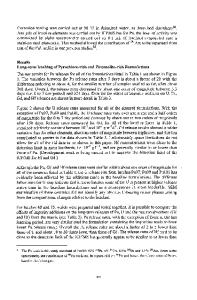Radiation Damage in Titanate Ceramics for Plutonium Immobilization
- PDF / 188,977 Bytes
- 8 Pages / 612 x 792 pts (letter) Page_size
- 28 Downloads / 302 Views
Radiation Damage in Titanate Ceramics for Plutonium Immobilization Denis M. Strachan, Randall D. Scheele, Anne E. Kozelisky, Richard L. Sell, H. Todd Schaef, Matthew J. O’Hara, Christopher F. Brown, and William C. Buchmiller Pacific Northwest National Laboratory, Richland, WA 99352, USA
Abstract Radiation damage experiments are being performed with pyrochlore and zirconolite in support of the disposition of surplus weapons-ready Pu. Pyrochlore becomes amorphous in approximately 1 year from the alpha recoil damage of ~ 1018 alphas/g from the decay of 238Pu. The dissolution rate of 238Pu-bearing ceramics increases with increasing radiation damage as measured in a 3 d MCC-1 test at 90°C. Over the same period, zirconolite retains substantial crystallinity albeit with broadened diffraction peaks. The dissolution rate also increases with increasing radiation damage. Introduction Some fraction of the Pu that the U.S. has declared as being surplus to its defense needs is to be incorporated into a titanate ceramic in the form of disks. These disks are to be placed in stainless steel cans that are subsequently loaded into magazines. The magazines are to be placed in an otherwise standard high-level waste canister and the canisters filled with high-level waste glass at the Defense Waste Processing Facility at the Savannah River Site in Aiken, SC. In this paper, we describe radiation damage experiments that are being performed in support of the need to demonstrate the long-term behavior of the titanate ceramic in a repository environment. As part of the licensing process for the national mined geologic nuclear waste repository, a safety case is being used in which the titanate ceramic under a worst-case scenario is assumed to interact with water and degrade [1]. Under certain conditions, incongruent release or transport of fissile Pu and/or 235U relative to the neutron absorbers Gd and Hf could lead to local and/or farfield nuclear criticality in the repository. To assess the possibility of this occurring, information is needed on the degradation behavior of the ceramic and the changes to the chemical and physical properties (most notably dissolution in water and cracking) as the crystalline materials are damaged from the decay of 239Pu to 235U. Extensive tests to determine the degradation behavior of the as-fabricated ceramic (i.e., not radiation-damaged) have been conducted as part of the Plutonium Immobilization Program. However, the alpha decay of 239Pu to 235U is expected to cause the loss of crystallinity in the titanate ceramic from radiation damage on a timescale of hundreds to thousands of years. This damage is accompanied by swelling and potential cracking of the ceramic. Both the loss of crystallinity and the potential increase in surface area from cracking could increase the rate at which the ceramic degrades when it comes in contact with water. Thus, it is important to investigate and document the effects of radiation damage because a ceramic in a repository will have suffered extensive radiation damage by the tim
Data Loading...











